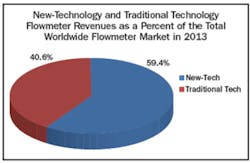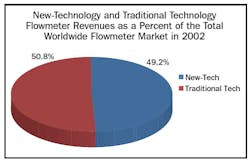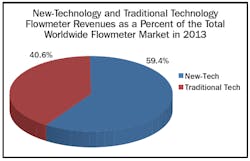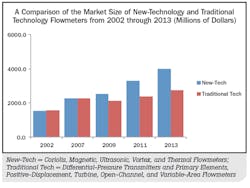Flow Research published the 5th Edition of its “Volume X: The World Market for Flowmeters” study in August 2014. In looking at the results of this study, it is clear that whether the flowmeter type has been around for hundreds of years or just a few decades, the drive toward technology improvement is fostering new opportunities for many meter suppliers.
After studying the flowmeter market for several years, Flow Research began classifying flowmeters introduced after 1950 as “new-technology” flowmeters and those introduced before 1950 as “traditional technology” flowmeters. This classification provided a convenient method to divide the leading technologies and also captured an important dynamic within the market. These terms were introduced in published articles as early as 2002 and became the basis for classification of flowmeters in the first “Volume X: World Market for Flowmeters” study published in 2003.
Flow Research published the 5th Edition of its Volume X study of the worldwide flowmeter market in August 2014. Looking at the most recent study results, as well as those of the intervening studies, reveals a great deal about how the worldwide flowmeter market has developed over the past 11 years. However, before looking at these numbers, it is important to look at one classification issue that arose in 2003.
READ ALSO: Introducing the ‘Multi-Tech’ Flowmeter – When Technologies Unite in the Name of Flow Measurement
Thermal Flowmeters Reclassified
After discussions extending over six months with thermal flowmeter suppliers and other industry experts, thermal flowmeters were reclassified as “new-technology” meters in October 2003. This is important to understand because in the first edition of “Volume X,” thermal flowmeters were still classified as traditional flowmeters. In all subsequent editions of this study, thermal flowmeters have been classified as new-technology flowmeters. In order to have an “apples to apples” comparison, the chart at the left includes the market size of thermal flowmeters with new-technology flowmeters all the way back to 2002, which shows how the relative size of these markets has changed over time.
Even with thermal included with new-technology flowmeters, the above chart shows that traditional technology flowmeters outpaced new-technology flowmeters in worldwide sales in 2002. In 2007, sales of new-technology flowmeters exceeded sales of traditional meters for the first time, and this trend has continued in succeeding years. In 2013, new-technology flowmeters accounted for just over 59 percent of the total worldwide flowmeter market.
The difference can also be seen by comparing the following two pie charts—one from 2002 and the other from 2013.
Why the Shift?
This shift from traditional to new technology is mainly driven by high growth in Coriolis and ultrasonic flowmeters. Both technologies have been approved for custody transfer of gases and liquids by the American Gas Association (AGA, www.aga.org), and the American Petroleum Institute (API, www.api.org). End-users are also opting for the more advanced technology and performance offered by new-technology meters, as their accuracy is generally higher, they typically have no moving parts, and they are in the lead in communication protocol technology.
The growing demand for energy and energy measurement has a lot to do with growth in the flowmeter markets in general. With oil selling in the range of $100 per barrel, companies are looking for highly accurate and reliable means of measuring it. At the same, the demand for natural gas is rising because natural gas is cleaner than oil, and it is seen as a long-term bridge to renewables. Multipath ultrasonic flowmeters are used for custody-transfer applications of oil and gas. And a new class of large line size Coriolis flowmeters has been developed for line sizes of 8–16 inches. These new Coriolis meters are mainly aimed at custody-transfer applications.
Don’t Count Out Traditional Technology Meters
Energy is also helping traditional meters hold their own for certain applications. Oval gear positive-displacement flowmeters, for example, are commonly incorporated into skids that are used in downstream distribution of petroleum liquids. Positive-displacement flowmeter suppliers have increased the reliability of their meters by using more lasting bearing materials and by introducing more precision into their manufacturing processes. Turbine suppliers have introduced ceramic and sapphire bearings, reversible-flow meters, dual-rotor meters, and enhanced diagnostics to better handle flow profile issues.
While the long-term shift to new-technology flowmeters is likely to continue, the combination of large installed base, supplier improvements, and growing energy applications will keep traditional technology flowmeters in service for a long time to come.
For more on Flow Research’s “Volume X: The World Market for Flowmeters, 5th Edition” study, visit, www.flowvolumex.com.
Jesse Yoder, Ph.D., is president of Flow Research Inc. in Wakefield, Mass., a company he founded in 1998. He has 27 years of experience as an analyst and writer in process control. Dr. Yoder specializes in flowmeters and other field devices, including pressure and temperature products. Dr. Yoder can be reached at [email protected].






